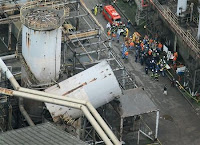Please spend December 2nd/3rd as
“Process Safety Day” in your organisation. Educate your personnel on the Bhopal Gas tragedy and its lessons. 27 years ago, on the night on December 2nd/3rd, 1984, on a wintry night in Bhopal, thousands of men, women and children died an excruciating death when MIC leaked from the Union Carbide factory. The survivors and the next generation children born to those exposed to the gas still are suffering from the effects of the gas. Bhopal is an ongoing tragedy and should never be forgotten. The Bhopal gas disaster comprises actually of three disasters - the first was the actual incident, the second was the inadequate compensation received and the third is the ongoing legacy of genetic defects and effects of the hazardous waste that has seeped into the ground water. Every plant operating, maintenance and safety personnel must never forget the lessons of Bhopal. They are still relevant today:
1. Do not cut costs without looking at the effects on process safety
2. Maintain all your layers of defense including asset integrity
3. Continually ensure that competency of personnel operating and maintaining plants are updated and current
4. Be prepared for the worst case scenario.
5. Understand the risks and measures to eliminate / reduce or control them
6. Learn from your past incidents. Those who do not learn are condemned to repeat the incidents.
7. Pay heed to your process safety management system audit reports
As you are aware, this blog is also dedicated to the surviving victims of Bhopal and for my regular subscribers, I appeal to you to buy my book "Practical Process Safety Management", the proceeds from which are donated to the surviving victims of Bhopal.Contact me at bkprism@gmail.com for buying the book.
See a presentation on the Bhopal Gas Tragedy by Vijita S Aggarwal, Associate Professor, University School of Management Studies,GGS Indraprastha University,Delhi, India in
this link. Read my older post comparing the Bhopal and the BP incident of 2005 in
this linkRead the then Police Chief’s account of the tragedy in
this link.
